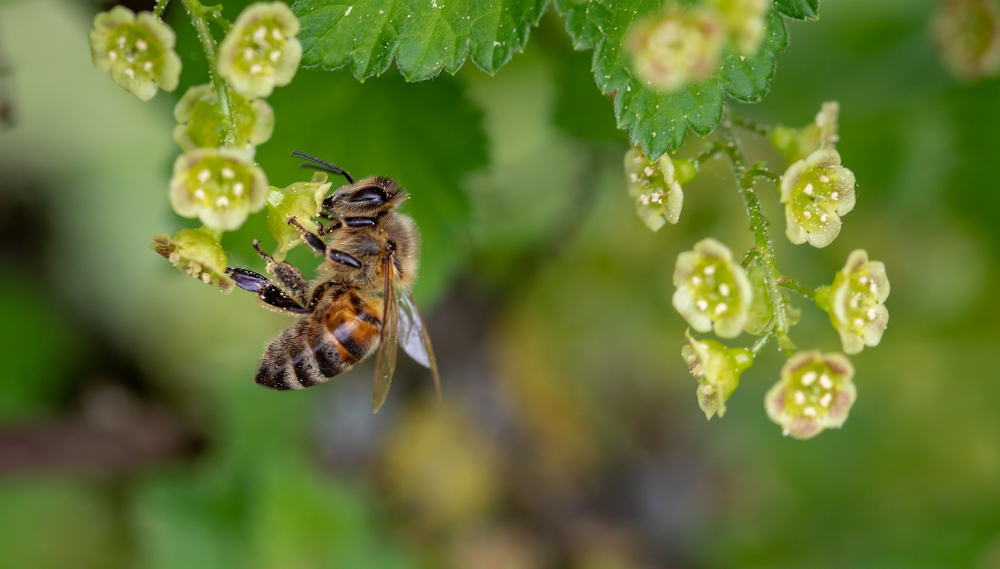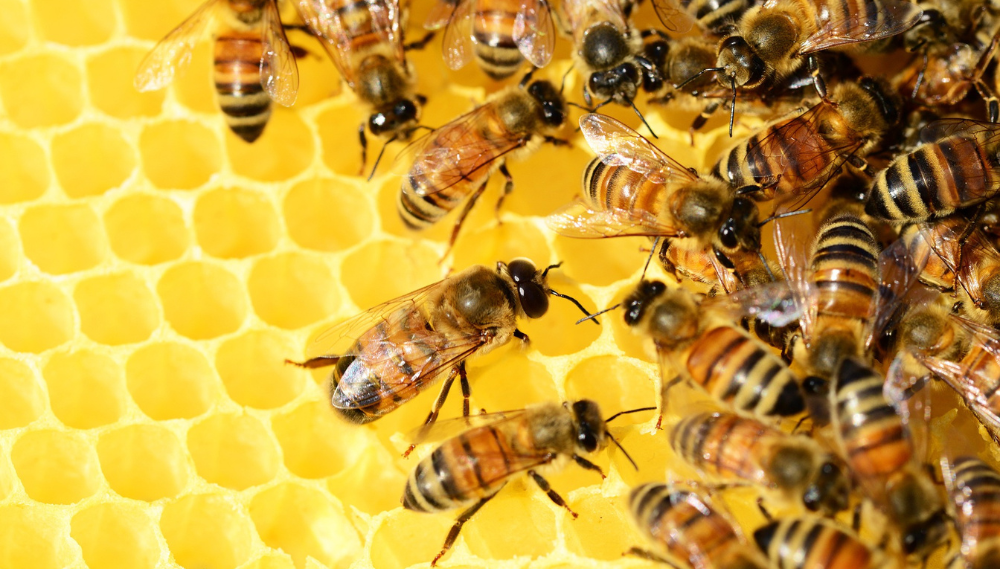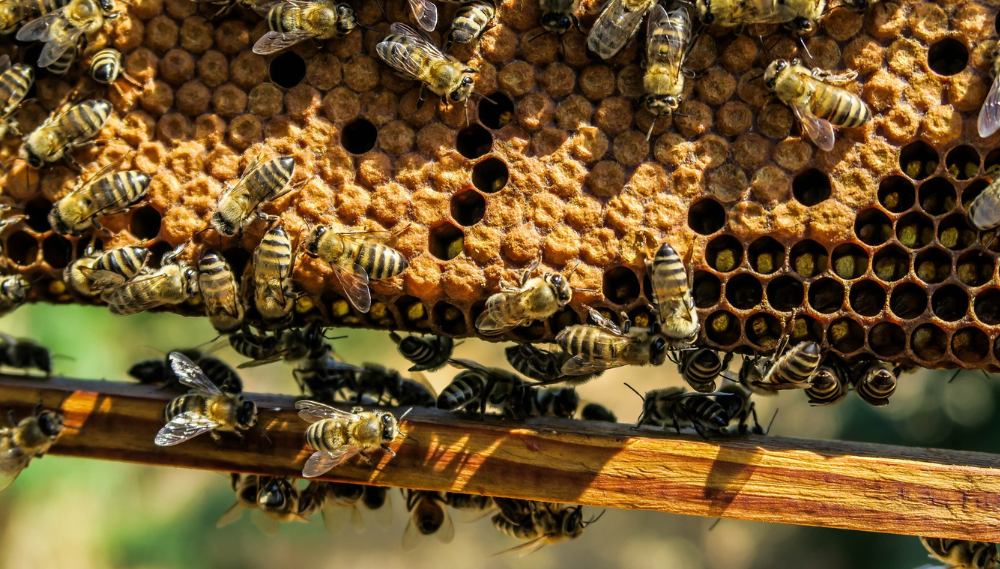Mason Bees vs Honey Bees – What’s the Difference?

As a keen gardener, you’re likely well accustomed to sharing your green space with bees. These powerful insects are responsible for pollinating our flowers, producing delicious honey, and maintaining our earth’s ecosystem. While we’re all familiar with the honey bee, there are actually over 20,000 species of bee worldwide – including mason bees.
The mason bee, a species most common in North America, is an effective pollinator that can do wonders for your garden. It can be tricky to figure out whether you’re looking at a mason bee, a honey bee, or an entirely different species. Our expert guide will help you identify which type of bee your garden is home to.
The Top 7 Differences Between Mason Bees and Honey Bees
Honey bees are larger, social insects that are famous for living together in hives and making honey. On the other hand, mason bees prefer to live alone, have smaller bodies, and like to make their nests in cracks and small holes. Even though they don’t produce honey as honey bees do, mason bees are still remarkable. They search for food across many plants, making them incredible pollinators.
Let’s look at the seven biggest differences between the mason and honey bee.

Family & Species
While both mason bees and honey bees look similar, they’re actually part of completely different families. Mason bees belong to the genus Osmia Lignaria of the Megachilidae bee family. Whereas honey bees belong to the genus Apis and are part of the Apidae family.
What does this mean? Well, masons are solitary bees that prefer to work and live alone, and honey bees spend their lives working for their hive. Differences are also clear in their appearance. We’ll cover this later.
Social Habits
The social habits of honey and mason bees are more complicated than solitary vs social. Their entire way of life is different. Female mason bees are responsible for building and finding food for their own nests and will lay their own eggs. They will spend their entire life alone, collecting resources for their larvae.
Honey bees, on the other hand, are highly social. They live in hives amongst thousands of other workers. A complex social hierarchy dominates the life of the honey bee. In every hive, there is a single queen, drones (males), and worker bees (females).
Laying eggs is the sole job of the queen. The worker bees will care for the brood while maintaining the hive.

Appearance
Spotting the physical differences between honey and mason bees is easy when you know what to look out for.
Perhaps the most obvious difference is the size of both insects. Honey bees are mostly larger, although it depends on factors like age and nutrition. If you’re trying to identify a bee in your garden, look out for their coloration.
Honey bees are a combination of golden and brown. Mason bees, on the other hand, often have a blue or green color on their bodies which is distinct from other bee species. Mason bees are also hairier than their honey counterparts and will have a fuzzy appearance.
Nesting Routines
As we know, honey bees live in large hives, and mason bees live alone. But they also have entirely different ways of constructing their homes. Honey bees make their nests by secreting beeswax from their abdomens. They build honeycombs to feed larvae.
Since they live alone, mason bees don’t need to build large and complex hives. Instead, they use mud and clay as their nesting materials. They nest in small holes like hollow stems or man-made structures. Clay forms small female egg chambers to make it easier for the mason bee to feed their brood.
Pollination
While we often thank honey bees for pollinating our plants, mason bees are powerhouses for spreading pollen and nectar.
Honey bees are picky when foraging. They only go for specific types of flowers like clovers, lavender, and sunflowers. Mason bees aren’t selective – they will pollinate anything from fruit trees to garden vegetables. If you grow your own fruit and veg, masons are your best friend!
You’ll see honey bees at all hours of the day. Mason bees, on the other hand, are active bright and early and can continue to pollinate well into the colder and cloudier months.

Honey Production
A common misconception is that mason bees don’t produce honey. They do, just in smaller quantities. All honey goes to feed their larvae.
Honeybees are known for their love of producing honey – they’re literally named after it! They make far more than they need, allowing us humans to harvest.
Behavior & Lifespan
Like most bees, both mason and honey bees have stingers as their main defense mechanism. However, both will act differently.
Since mason bees don’t have a hive to protect, they won’t sting you unless they feel threatened. You’ll probably physically touch a mason to get a nasty sting. Honeybees are all about protecting their hive from danger. If you get too close to their home or interrupt their pollination, they will become aggressive.
Honey bees can live between two and six weeks in the summer and up to 20 weeks in the winter. Mason bees have a much shorter lifespan, living for just a few weeks as an adult. Unlike a hive, which produces thousands of bees, masons lay eggs individually, which is why you may see far less of them around.
Attracting Mason Bees to Your Garden – a Quick Guide
To attract more mason bees to your garden and benefit from their pollination capabilities, follow this quick guide:
1. Offer Nesting Spots
Mason bees prefer nesting in ready made spaces like hollow plant stems, woodpecker holes or bee houses. You can install bee houses or create nesting sites by drilling holes of different sizes in wooden blocks around your garden.
2. Plant Bee Friendly Flowers
To attract mason bees you should plant plenty of flowering plants that bloom at different times of the year. Choose flowers with different shapes, colors and sizes to provide mason bees with lots of nectar and pollen.
3. Minimize Pesticide Use
You should always limit the use of pesticides in your garden. These chemicals can harm not only bees but also other insects. Opt for organic pest control methods that focus on the health of your garden and all its residents.
4. Provide Mud Sources
Mason bees need mud for making their nests, so make sure there are suitable mud sources nearby. You can keep a shallow tray filled with damp clay or mud in your garden to attract mason bees that need materials.

Final Thoughts
Attracting mason bees to your garden is a fantastic way to keep your plants happy and thriving. Throw a welcome party for these important pollinators by providing nesting spots and planting colorful flowers.
Protect your native bee species by paying attention to the needs of masons and watch your garden thrive.
Frequently Asked Questions
Read our frequently asked questions on mason bees to help you attract them to your garden.
Do Mason Bees Sting?
Mason bees sting but are generally calm insects. They are unlikely to sting unless they feel provoked or handled roughly. Unlike honey bees, they don’t have a hive to protect, which means they don’t pose much of a risk to us.
How Do I Build a Mason Bee House?
You can create a mason bee house with basic materials like wood, bamboo tubes and cardboard. Make holes of different sizes (ranging from 6 to 10 mm) in a block of wood or a stack of boards. Make sure the holes are clean and clear of any dirt or debris. Hang the bee house in a sunny spot that is wind protected, facing either southeast or southwest.
What are the Native Bees in North America?
In North America, there are more than 4,000 types of bees that are native to the region. These include mason bees, bumblebees, sweat bees, carpenter bees and leafcutter bees.
When do Mason Bees Emerge?
Mason bees will come out of their nests during the early spring, when temperatures reach around 55 to 60°F (13 to 16°C). They are some of the first bees to start pollinating in the springtime. They will forage and pollinate your garden in the entire growing season, making them a great friend for your green spaces.
What Should I Do If I Find a Mason Bee Nest?
If you stumble on a mason bee nest in your garden, it’s best to leave it be without disturbing it. Because bees are such good pollinators, it’s important not to disrupt their natural behaviour by disturbing their nest.
How Far Do Mason Bees Travel to Find Food?
When foraging for food, mason bees usually travel within a range of 300 feet from their nesting site. If they don’t have enough food, they may venture out further. For mason bees to visit your garden, you should cultivate flowering plants, fruits, and vegetables so they have plenty of food within reach.